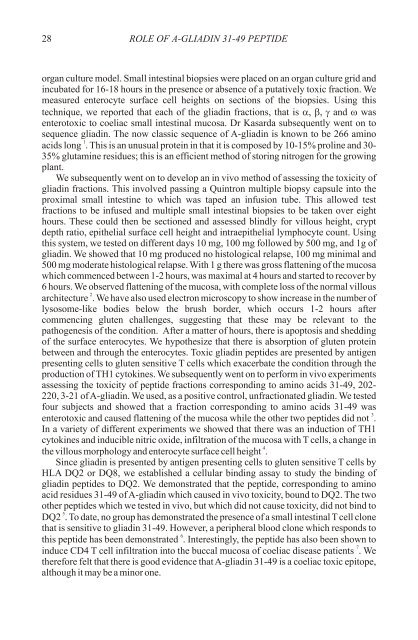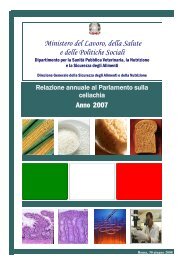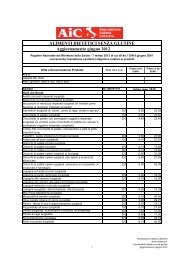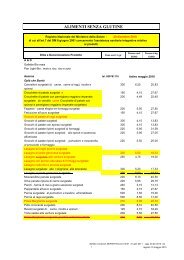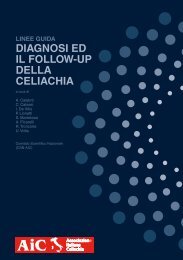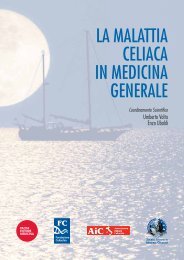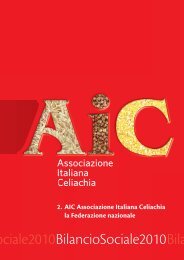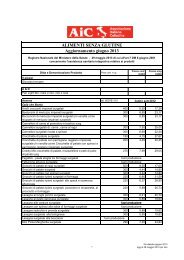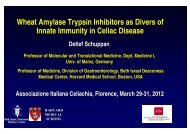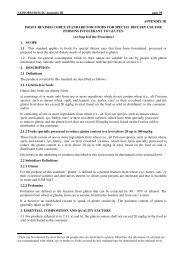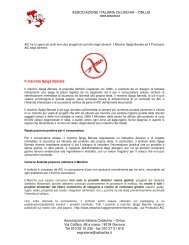primary prevention of coeliac disease - Associazione Italiana ...
primary prevention of coeliac disease - Associazione Italiana ...
primary prevention of coeliac disease - Associazione Italiana ...
You also want an ePaper? Increase the reach of your titles
YUMPU automatically turns print PDFs into web optimized ePapers that Google loves.
28 ROLE OF A-GLIADIN 31-49 PEPTIDE<br />
organ culture model. Small intestinal biopsies were placed on an organ culture grid and<br />
incubated for 16-18 hours in the presence or absence <strong>of</strong> a putatively toxic fraction. We<br />
measured enterocyte surface cell heights on sections <strong>of</strong> the biopsies. Using this<br />
technique, we reported that each <strong>of</strong> the gliadin fractions, that is a, b, gand was<br />
enterotoxic to <strong>coeliac</strong> small intestinal mucosa. Dr Kasarda subsequently went on to<br />
sequence gliadin. The now classic sequence <strong>of</strong> A-gliadin is known to be 266 amino<br />
1<br />
acids long . This is an unusual protein in that it is composed by 10-15% proline and 30-<br />
35% glutamine residues; this is an efficient method <strong>of</strong> storing nitrogen for the growing<br />
plant.<br />
We subsequently went on to develop an in vivo method <strong>of</strong> assessing the toxicity <strong>of</strong><br />
gliadin fractions. This involved passing a Quintron multiple biopsy capsule into the<br />
proximal small intestine to which was taped an infusion tube. This allowed test<br />
fractions to be infused and multiple small intestinal biopsies to be taken over eight<br />
hours. These could then be sectioned and assessed blindly for villous height, crypt<br />
depth ratio, epithelial surface cell height and intraepithelial lymphocyte count. Using<br />
this system, we tested on different days 10 mg, 100 mg followed by 500 mg, and 1g <strong>of</strong><br />
gliadin. We showed that 10 mg produced no histological relapse, 100 mg minimal and<br />
500 mg moderate histological relapse. With 1 g there was gross flattening <strong>of</strong> the mucosa<br />
which commenced between 1-2 hours, was maximal at 4 hours and started to recover by<br />
6 hours. We observed flattening <strong>of</strong> the mucosa, with complete loss <strong>of</strong> the normal villous<br />
2<br />
architecture . We have also used electron microscopy to show increase in the number <strong>of</strong><br />
lysosome-like bodies below the brush border, which occurs 1-2 hours after<br />
commencing gluten challenges, suggesting that these may be relevant to the<br />
pathogenesis <strong>of</strong> the condition. After a matter <strong>of</strong> hours, there is apoptosis and shedding<br />
<strong>of</strong> the surface enterocytes. We hypothesize that there is absorption <strong>of</strong> gluten protein<br />
between and through the enterocytes. Toxic gliadin peptides are presented by antigen<br />
presenting cells to gluten sensitive T cells which exacerbate the condition through the<br />
production <strong>of</strong> TH1 cytokines. We subsequently went on to perform in vivo experiments<br />
assessing the toxicity <strong>of</strong> peptide fractions corresponding to amino acids 31-49, 202-<br />
220, 3-21 <strong>of</strong> A-gliadin. We used, as a positive control, unfractionated gliadin. We tested<br />
four subjects and showed that a fraction corresponding to amino acids 31-49 was<br />
3<br />
enterotoxic and caused flattening <strong>of</strong> the mucosa while the other two peptides did not .<br />
In a variety <strong>of</strong> different experiments we showed that there was an induction <strong>of</strong> TH1<br />
cytokines and inducible nitric oxide, infiltration <strong>of</strong> the mucosa with T cells, a change in<br />
4<br />
the villous morphology and enterocyte surface cell height .<br />
Since gliadin is presented by antigen presenting cells to gluten sensitive T cells by<br />
HLA DQ2 or DQ8, we established a cellular binding assay to study the binding <strong>of</strong><br />
gliadin peptides to DQ2. We demonstrated that the peptide, corresponding to amino<br />
acid residues 31-49 <strong>of</strong> A-gliadin which caused in vivo toxicity, bound to DQ2. The two<br />
other peptides which we tested in vivo, but which did not cause toxicity, did not bind to<br />
5<br />
DQ2 . To date, no group has demonstrated the presence <strong>of</strong> a small intestinal T cell clone<br />
that is sensitive to gliadin 31-49. However, a peripheral blood clone which responds to<br />
6<br />
this peptide has been demonstrated . Interestingly, the peptide has also been shown to<br />
7<br />
induce CD4 T cell infiltration into the buccal mucosa <strong>of</strong> <strong>coeliac</strong> <strong>disease</strong> patients . We<br />
therefore felt that there is good evidence that A-gliadin 31-49 is a <strong>coeliac</strong> toxic epitope,<br />
although it may be a minor one.


